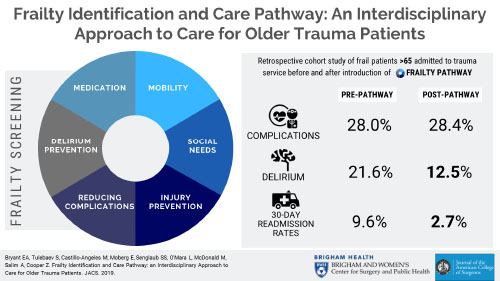Older patients face a unique set of health challenges—including chronic fatigue, low muscle mass, cognitive impairment, bone fractures, and reduced mobility—that can raise their risk of illness or injury during hospitalization.
According to Zara Cooper, MD, MSc, a member of the Stepping Strong medical executive committee and director of the Brigham’s Center for Surgery and Public Health, “Frailty and cognitive impairment are often key contributing factors in falls and accidents that lead to fractures and other injuries among older patients. We believe that focusing on these underlying conditions is essential to optimizing care and outcomes.”
Launched in 2016, the Brigham’s SSTEP Pathway (formally called the BWH Frailty Identification and Care Pathway) is a multidisciplinary program that addresses challenges for elderly patients by providing clinicians with standardized guidelines for identifying and accommodating frailty—a complex, often age-related syndrome characterized by physical decline and increased vulnerability to stressors.
The SSTEP Pathway screens patients aged 65 years or older for frailty to determine whether they are frail or at risk of becoming frail. If screened positive for frailty, patients receive geriatric-centered orders aimed at preventing delirium and improving function. Additionally, SSTEP patients are seen by experts in gerontology, nutrition, and physical therapy.
Read an article about how the pathway has lowered readmission rates in older adult trauma patients.
Contact Lynne O’Mara to learn more about SSTEP program.

